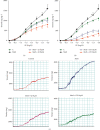Antiglycation Activities and Common Mechanisms Mediating Vasculoprotective Effect of Quercetin and Chrysin in Metabolic Syndrome
- PMID: 32802123
- PMCID: PMC7403910
- DOI: 10.1155/2020/3439624
Antiglycation Activities and Common Mechanisms Mediating Vasculoprotective Effect of Quercetin and Chrysin in Metabolic Syndrome
Abstract
Multiple risk factors combine to increase the risk of vascular dysfunction in patients suffering from metabolic syndrome (MetS). The current study investigates the extent to which quercetin (Q) and chrysin (CH) protect against vascular dysfunction in MetS rats. MetS was induced by feeding rats a high-salt diet (3%) and fructose-enriched water (10%) for 12 weeks. Thoracic aorta was isolated from MetS rats and from control rats, with the latter being injured by methylglyoxal (MG). Aortae were incubated with CH and Q, and vascular reactivity was evaluated through the analysis of aortic contraction and relaxation in response to PE and ACh, respectively. The formation of advanced glycation end products (AGEs) and the free radical scavenging activity of 1,1-diphenyl-2-picrylhydrazyl (DPPH) were also evaluated following the introduction of CH and Q. The increased vasoconstriction and impaired vasodilation in MetS aortae were significantly ameliorated by Q and CH. Similarly, they ameliorated glycation-associated exaggerated vasoconstriction and impaired vasodilation produced by MG in control aortae. In addition, both Q and CH were effective in reducing the formation of AGEs and inhibition of glycosylation in response to MG or fructose treatment. Finally, Q successfully scavenged DPPH free radicals while CH showed significant vasodilation of precontracted aorta that was inhibited by L-NAME. In conclusion, Q and CH provide protection against vascular dysfunction in MetS by interfering with AGEs formations and AGEs-associated vascular deterioration, with CH being largely dependent on NO-mediated mechanisms of vasodilation.
Copyright © 2020 Osama A. A. Ahmed et al.
Conflict of interest statement
The authors declare that they have no conflicts of interest regarding the publication of this paper.
Figures







Similar articles
-
Interference with AGEs formation and AGEs-induced vascular injury mediates curcumin vascular protection in metabolic syndrome.Sci Rep. 2020 Jan 15;10(1):315. doi: 10.1038/s41598-019-57268-z. Sci Rep. 2020. PMID: 31941978 Free PMC article.
-
Geraniol improves the impaired vascular reactivity in diabetes and metabolic syndrome through calcium channel blocking effect.J Diabetes Complications. 2016 Aug;30(6):1008-16. doi: 10.1016/j.jdiacomp.2016.04.006. Epub 2016 Apr 12. J Diabetes Complications. 2016. PMID: 27131411
-
Phenolics from Garcinia mangostana alleviate exaggerated vasoconstriction in metabolic syndrome through direct vasodilatation and nitric oxide generation.BMC Complement Altern Med. 2016 Sep 13;16(1):359. doi: 10.1186/s12906-016-1340-5. BMC Complement Altern Med. 2016. PMID: 27618982 Free PMC article.
-
Limonin alleviates macro- and micro-vascular complications of metabolic syndrome in rats: A comparative study with azelnidipine.Phytomedicine. 2018 Apr 1;43:92-102. doi: 10.1016/j.phymed.2018.03.044. Epub 2018 Mar 26. Phytomedicine. 2018. PMID: 29747759
-
Psiadia punctulata major flavonoids alleviate exaggerated vasoconstriction produced by advanced glycation end products.PLoS One. 2019 Sep 6;14(9):e0222101. doi: 10.1371/journal.pone.0222101. eCollection 2019. PLoS One. 2019. PMID: 31491007 Free PMC article.
Cited by
-
A Nano-Pharmaceutical Formula of Quercetin Protects from Cardiovascular Complications Associated with Metabolic Syndrome.Front Pharmacol. 2021 Aug 11;12:696981. doi: 10.3389/fphar.2021.696981. eCollection 2021. Front Pharmacol. 2021. PMID: 34456723 Free PMC article.
-
Enhancing impact of dietary nano formulated quercetin on laying performance: egg quality, oxidative stability of stored eggs, intestinal immune and antioxidants related genes expression.BMC Vet Res. 2024 Oct 29;20(1):494. doi: 10.1186/s12917-024-04327-x. BMC Vet Res. 2024. PMID: 39472914 Free PMC article.
-
Rp-HPLC Determination of Quercetin in a Novel D-α-Tocopherol Polyethylene Glycol 1000 Succinate Based SNEDDS Formulation: Pharmacokinetics in Rat Plasma.Molecules. 2021 Mar 6;26(5):1435. doi: 10.3390/molecules26051435. Molecules. 2021. PMID: 33800848 Free PMC article.
-
Advanced glycosylation end products promote the progression of CKD-MBD in rats, and its natural inhibitor, quercetin, mitigates disease progression.Naunyn Schmiedebergs Arch Pharmacol. 2024 Dec;397(12):9675-9688. doi: 10.1007/s00210-024-03217-1. Epub 2024 Jun 22. Naunyn Schmiedebergs Arch Pharmacol. 2024. PMID: 38907848
-
Experimental and hypothetical appraisal on inhibition of glucose-induced glycation of bovine serum albumin by quercetin.J Genet Eng Biotechnol. 2023 Nov 16;21(1):123. doi: 10.1186/s43141-023-00588-5. J Genet Eng Biotechnol. 2023. PMID: 37971629 Free PMC article.
References
LinkOut - more resources
Full Text Sources

